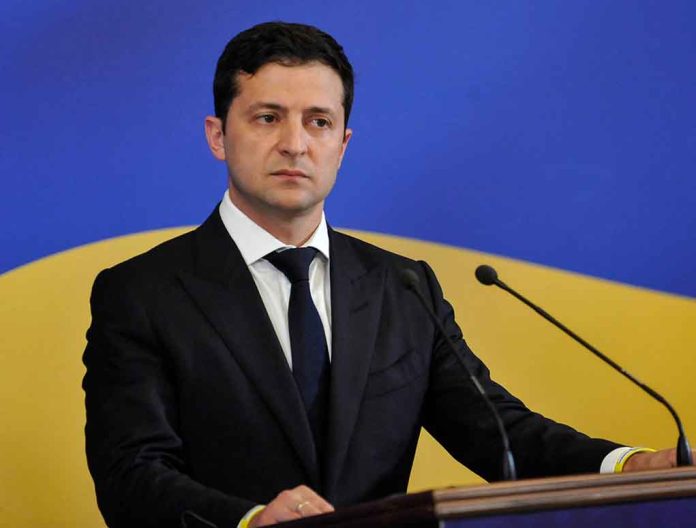
Ukrainian soldiers resort to shotguns as the unlikely hero against Russian fiber-optic drones that have evaded sophisticated electronic warfare countermeasures.
Key Takeaways
- Russia’s fiber-optic drones operate via physical cables, making them immune to traditional jamming techniques
- Shotguns have emerged as the most effective tool against these advanced drones due to their reliability and accessibility
- Over 60,000 Ukrainian soldiers have received specialized training in anti-drone shotgun tactics
- High-end air defense systems are being reserved for more significant threats, as they’re too costly to deploy against inexpensive drones
- Alternative technologies like net-firing pistols are in development but not yet widely available to Ukrainian forces
The Rise of Unjammable Drones
As the conflict in Ukraine continues, Russian forces have deployed increasingly sophisticated drone technology to gain battlefield advantages. Among these innovations are fiber-optic drones that maintain their connection through physical cables rather than wireless signals. This technological adaptation has rendered traditional electronic warfare tactics ineffective, forcing Ukrainian defenders to develop alternative countermeasures. These cable-tethered drones represent a significant evolution in unmanned aerial threats, as they operate outside the spectrum of electronic jamming that has successfully neutralized earlier drone models.
The battlefield dynamics have shifted dramatically with these drones providing Russian forces with surveillance capabilities that can’t be disrupted remotely. For Ukrainian forces, this presents an urgent challenge requiring immediate tactical solutions rather than waiting for matching technological developments. The immunity these drones have to electronic countermeasures has created a vulnerability gap that threatens Ukrainian defensive positions along the front lines, necessitating the implementation of more direct and physical intervention methods.
Shotguns: The Unexpected Anti-Drone Weapon
Ukrainian military strategists have turned to an old-school solution for this high-tech problem—the shotgun. The 12-gauge shotgun has become the weapon of choice for front-line troops facing fiber-optic drone threats. Its spread pattern provides a higher probability of hitting small, moving aerial targets compared to rifles or pistols. This practical approach has proven remarkably effective where modern electronic countermeasures have failed. The shotgun’s simplicity also means soldiers can deploy this defense with minimal specialized equipment, making it an ideal solution for widespread implementation across various units.
Training programs have been established to develop proficiency in spotting and shooting down these drones. Ukrainian military instructors focus on teaching soldiers to track the drone’s movement patterns and anticipate their flight paths before taking the shot. With over 60,000 soldiers trained in these anti-drone tactics, Ukraine has created a distributed defense network capable of responding to drone threats throughout the conflict zone. The emphasis on this training demonstrates the seriousness with which the Ukrainian command views this threat.
The Cost-Effectiveness of Low-Tech Solutions
The economics of drone warfare have pushed Ukrainian forces toward these pragmatic solutions. Using expensive air defense systems to counter relatively inexpensive drones creates an unsustainable cost imbalance. A single high-end missile can cost hundreds of thousands of dollars, while the drones they target might cost only a few thousand. Shotguns, with ammunition costing just dollars per shell, represent a financially viable defense strategy. This cost-effectiveness allows Ukrainian forces to reserve their sophisticated air defense systems for countering more significant threats like missiles and aircraft.
While alternative technologies such as specialized net guns are being developed, their limited availability means shotguns remain the primary defense against fiber-optic drones. The immediate accessibility of shotguns, combined with their straightforward operation, makes them particularly valuable in a conflict where resources must be carefully allocated. Ukrainian forces continue to innovate with training simulators that help improve soldiers’ accuracy against small, fast-moving aerial targets, ensuring this low-tech solution maintains maximum effectiveness against evolving drone threats.
The Changing Nature of Warfare
The extensive use of drones in the Ukrainian conflict represents an unprecedented shift in modern warfare. The battlefield has become increasingly saturated with unmanned aerial vehicles from both sides, creating a complex environment where identifying friend or foe presents significant challenges. This drone-dense battlespace has necessitated rapid adaptation of tactics and training, with Ukrainian forces pioneering solutions that combine traditional weaponry with modern threats. The lessons learned from this conflict will likely influence military doctrine worldwide for decades to come.
President Trump’s administration has monitored these developments closely, recognizing the implications for future conflicts and defense planning. The blend of high-tech threats and low-tech countermeasures demonstrates the unpredictable nature of modern warfare and the importance of tactical flexibility. As President Zelenskyy’s forces continue to defend Ukrainian territory, their innovative approaches to battlefield challenges show that sometimes the most effective solutions aren’t the most sophisticated ones—they’re the most practical.







